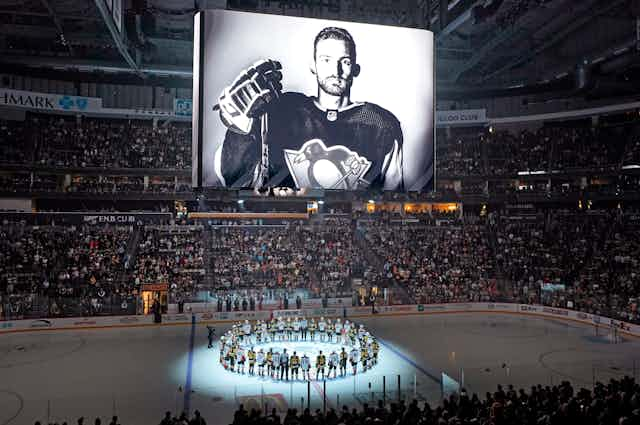The death of professional ice hockey player Adam Johnson from a freak injury has renewed debates about protective hockey equipment. On Oct. 28, the 29-year-old died after being cut in the neck by a skate blade during an English league hockey game.
In the days since Johnson’s death, hockey players and organizations have called for neck guard mandates. Neck guards are designed to prevent a cut to the neck, rather than spinal cord or throat injuries from a puck or stick. They are available as stand-alone protective gear or embedded into a turtleneck long sleeve.
Hayley Wickenheiser — four-time Olympic gold medallist, medical doctor and assistant general manager for the Toronto Maple Leafs — has called for mandating neck protection at “every level in hockey.”
The Western Hockey League and the Pittsburgh Penguins ECHL and AHL teams now require players to wear neck guards, and more leagues are expected to follow. The English Ice Hockey Association will also require players to wear neck guards beginning in 2024. However, the United Kingdom’s Elite Ice Hockey League will not.
Currently, Hockey Canada mandates goaltenders and players registered in minor and female hockey programs wear BNQ-certified throat protectors. However, junior and senior athletes are exempt from this rule.
While the NHL hasn’t yet announced it will mandate neck protection, the history of protective hockey equipment suggests this could change in the future.
Close calls not enough
Johnson’s fatal injury is eerily reminiscent of injuries sustained by Florida Panthers winger Richard Zedník in 2008 and Buffalo Sabres goaltender Clint Malarchuk in 1989.
In both cases, a player lost balance after a collision, accidentally swinging their foot upward into the injured player’s neck. Fortunately, Zedník and Malarchuk recovered from their life-threatening injuries, but despite the close calls, the NHL did not require players to wear neck guards.
In ice hockey, the adoption of protective gear has historically been reactive, with catastrophic injuries often serving as the catalyst for change.
“Safety evolutions have usually needed death or serious injury to occur first,” sports journalist Geoff Baker wrote in the Seattle Times.
Gloves, shin guards, wrist guards and elbow and knee pads only became standard after players sustained serious injuries like broken bones, fractures and tears.
In the NHL, it wasn’t until 1979 — years after players sustained dental injuries or deadly head and brain injuries — that players were mandated to wear helmets. And it wasn’t until the 2013–14 season that they finally required players to wear visors to prevent eye injuries.
Resistance to implementing safety precautions
Why aren’t neck protectors mandatory at all levels of hockey? Some blame hockey culture itself, where change is slow and safety standards are inconsistent.
In the past, players have resisted wearing protective gear due to discomfort or signalling weakness. However, in the modern era, players, coaches and teams appear to be more attuned to safety issues.
One reason neck protectors aren’t mandated could be because neck lacerations from skate blades occur infrequently and are often not severe. In a 2009 study, researchers surveyed over 25,000 USA Hockey players to understand more about cuts to the neck by skate blades.
The researchers found that 45 per cent of players (mostly 13 to 18 years of age) reported wearing a neck guard while playing hockey, and only two per cent sustained a cut to the neck area by a skate blade. Nearly a quarter of the players who had a laceration were wearing a neck guard at the time of injury.

In follow-up interviews with 33 of the 485 injured players, researchers found that most of the cuts to the neck were superficial, meaning they only required bandaging or a few stitches.
Given the high-speed, high-contact nature of ice hockey, it is surprising that freak accidents don’t occur more often. While a neck slash injury by a skate blade is uncommon, the outcome may be fatal. A close call is still too close.
A neck protection mandate is not enough
While wearing a neck guard doesn’t guarantee an injury will not occur, it is still our best shot at preventing fatal accidents.
In addition to mandates, we need to ensure that neck guards are tested under realistic conditions that replicate the collisions that lead to injury on the rink. Although neck protector standards exist in Canada, only one independent study has evaluated the effectiveness of neck guards in preventing cuts to the neck.
A 2015 study evaluated 14 commercially available neck guards, using a custom-made machine which took a skate blade and cut neck guards under similar forces and speeds seen in game play. Materials such as Spectra Guard and Kevlar were found to be the most cut-resistant, but more research is needed.
In the wake of a tragic incident, we may find ourselves on the edge of an equipment evolution to improve player safety. Together — as players, hockey and standard organizations, industry partners and researchers — we can ensure that accidents don’t cost any more lives in the future.

